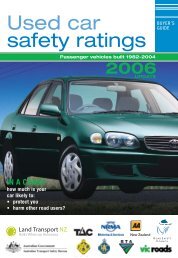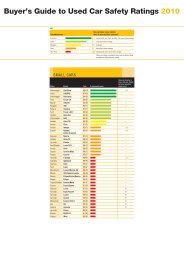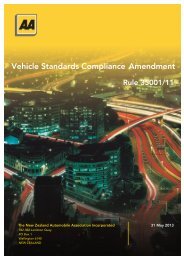ASSESSING FITNESS TO DRIVE
ASSESSING FITNESS TO DRIVE
ASSESSING FITNESS TO DRIVE
You also want an ePaper? Increase the reach of your titles
YUMPU automatically turns print PDFs into web optimized ePapers that Google loves.
<strong>ASSESSING</strong> <strong>FITNESS</strong> <strong>TO</strong> <strong>DRIVE</strong><br />
A matter of risk ?
Why Do Occupational Therapists Undertake<br />
Driving Assessments<br />
In a nutshell<br />
• Occupational Therapists are interested in how people function<br />
and interact with their environment on a day to day basis<br />
especially those mundane everyday activities we all take for<br />
granted and do without a second thought<br />
• Driving for the majority of people is a routine daily activity.<br />
• The objective is if at all possible to keep people driving rather<br />
than reduce their independence.
The purely medical issues<br />
related to fitness to driving<br />
are the responsibility of the<br />
Physicians not the Occupational<br />
Therapists
Occupational Therapists become involved with driving primarily<br />
related to three issues:<br />
1) An individual’s ability to drive and the need for vehicle modifications<br />
2) An individual's cognitive function related to driving<br />
3) To a lesser extent some vision problems especially related to grey areas around<br />
visual fields<br />
Driving related to physical ability and cognitive function<br />
is all about risk
The chance of bad consequences<br />
Exposure<br />
To the<br />
risk of injury
What’s Up Officer ?
Valet Parking
What our Office Manager does off duty
Was the head not screwed on the right way<br />
round ?
Driving Assessment is an exercise in risk<br />
assessment and management<br />
Are They Safe To Drive<br />
Yes<br />
No<br />
A range of well, sort of depending…
Physical Driving Ability<br />
Where an individual has a physical<br />
deficit (excluding vision) in many<br />
cases the technology exists to<br />
compensate for that deficit.<br />
These include a range of<br />
modifications from the simple to<br />
the technologically advanced.<br />
Arms and legs are not required to<br />
drive.
Modifications range from a simple knob on the steering wheel through to EMC joystick<br />
steering<br />
Steering and Indicator Extension<br />
Left Hinged Accelerator Pedal
Menox Hand Control<br />
Cullen Hand Control
Cognitive Function Related to Driving<br />
Cognitive function related to driving is the most difficult area to assess<br />
and the one with the greatest potential for disaster.
What Does The Assessment Involve<br />
A two part assessment involving<br />
An Off Road Driving Assessment<br />
An On Road Driving Assessment
The Off Road Assessment<br />
The Off Road Assessment is designed to assess a<br />
number of areas:<br />
We need to know:<br />
• Where the client normally drives?<br />
• What type of car they drive?<br />
• Is their Driver’s Licence current?<br />
• Are there any residual physical<br />
problems which may affect driving?<br />
- Hemiparesis<br />
- Tone<br />
- Functional movement<br />
- Co-ordination<br />
- Sensation etc<br />
Vision – Visual Field Deficits<br />
If present then a referral is made to<br />
an Optometrist for visual field<br />
testing, that is does the individual<br />
have the required 140 of<br />
horizontal visual field to drive. If<br />
not then no driving.
Cognitive Function<br />
A computer based assessment called the CanDAT<br />
(the Canterbury Driving Assessment Tool)
What Does The CanDAT Assess ?<br />
• Visuomotor Skills/Visuoperceptual Skills<br />
• Reaction Time<br />
• Speed of Information Processing<br />
• Movement Speed<br />
• Visual Spatial Ability<br />
• Divided Attention<br />
• Complex Attention<br />
• Planning
What Do The Results Mean ?<br />
In addition to the overall impaired pass/fail/no clear result the<br />
individual sub tests can be indicative of potential problems<br />
related to in terms of driving in familiar areas versus unfamiliar<br />
and low complexity versus high complexity
The On Road Assessment<br />
Lets go for a drive…..<br />
The On Road drive is undertaken in the<br />
individual’s own car or one of the<br />
assessment cars if required.<br />
The assessment is undertaken by a Driving<br />
Instructor and the Occupational Therapist.<br />
The Driving Instructor’s job is to give<br />
directions and “risk manage”, that is<br />
intervene in the driving if required.<br />
The Occupational Therapist marks the<br />
assessment sheet
The drive begins in the individual’s own area and covers places where they would<br />
normally drive.<br />
Part of the assessment drive will be in less familiar areas and will involve<br />
different driving situations such as the local shopping area, suburban and<br />
back streets, and the motorway or highway if appropriate.
The On Road Assessment is NOT a driving test of the type required to sit or<br />
retain a Driver’s Licence.<br />
The assessment focus is on a range of behaviours which can be associated with<br />
cognitive function.<br />
These include<br />
• The ability to apply priority rules<br />
•The ability to make a decision in a reasonable time acting appropriately<br />
•Observe and recognise signs (includes knowing you are at a give way or stop sign).<br />
•Reacting in time to hazards, i.e. late braking for other vehicles, intersections, bends in<br />
the road, pedestrians, including inappropriate stopping for empty pedestrian crossings<br />
and intersections<br />
•Selecting correct lanes<br />
•The ability to self navigate from point to point selecting an appropriate route
The assessment also looks for pre-existing habits such as:<br />
•Failure to blind spot check when moving off and with lane changes.<br />
•Stopping too close to the car in front.<br />
•Following too close – two second rule.<br />
•Minor speed limit infringements.<br />
•Failure to consistently indicate.<br />
•If a manual car<br />
– clutch coasting<br />
- neutral coasting<br />
- occasional incorrect gear selection<br />
- riding the clutch<br />
The Assessor looks at the range of negative driving behaviours and makes some<br />
judgments about how that affects overall driving safety. What are the patterns of<br />
behaviours occurring and are they just bad habits or is it behaviours associated with<br />
cognitive impairment.
The bottom line is:<br />
1) Does the Driving Instructor physically intervene in the<br />
individual’s driving to prevent a crash or near miss?<br />
2) Are the behaviours/errors:<br />
- Bad habits but not unsafe<br />
- Less safe<br />
- Unsafe<br />
- Potentially dangerous<br />
- Overtly dangerous.<br />
This is taken in context of where the individual lives, wishes to drive and the<br />
complexity of the driving situation the individual is likely to drive in,<br />
physical status and insight into difficulties.<br />
The outcome can be expressed in terms of high or low risk.
LICENCE ISSUES<br />
• Occupational Therapists have no power to grant or revoke a Driver’s<br />
Licence<br />
• Current NZ Transport Agency rules allow the Medical Section of the<br />
NZ Transport Agency to act upon the recommendations contained in a<br />
formal Driving Assessment report<br />
• The Occupational Therapist recommendations may include:<br />
1) Resume/continue unrestricted driving<br />
2) Resume /continue driving, but with limitations<br />
a) Time of day<br />
b) Distance from home<br />
3) Revocation of a Driver’s Licence<br />
4) Essential vehicle features<br />
a) Automatic only<br />
b) With vehicle modifications<br />
Whatever the limitation placed on a licence it must be realistic and<br />
enforceable
COSTS<br />
• The Occupational Therapy Driving Assessment is highly<br />
specialised<br />
• The full assessment takes up to four hours with a<br />
comprehensive report which is legally defensible<br />
• A Driving Instructor is required for risk management<br />
• The On Road Assessment is often undertaken in the<br />
client’s own environment which often involves travel<br />
Depending on where the person lives and the travel involved a full<br />
assessment can cost between $350.00 and $550.00
Thank<br />
You









